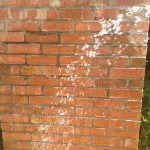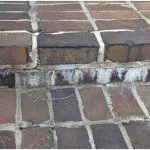16 Aug 2012
Ivy on Brick – Is it a Concern?

You should be concerned about ivy on brick if cracks appear, the mortar is crumbling, or brick is loose. Ivy leafs won’t cause damage but the roots growing in these vulnerable areas of the wall can expand cracks allowing water to penetrate the surface. I know one incident where the ivy opened a caulked crack in a foundation and water seeped in. Homes built before 1930 may be susceptible to damage because of the softer lime-based mortar used then. Mortar replacement or what’s called repointing, may be required.
Tuckpointing ivy covered brick requires removing or carefully pulling the ivy loose to apply a coating of cement-based mortar over existing joints. The ivy can then be repositioned or replanted. The ivy at Wrigley Field is Boston Ivy and Japanese Bittersweet. Bill Veeck planted it in 1937 during an outfield beautification project.
For your own beautification project keep the brick and mortar in good shape. The ivy won’t infiltrate a well-built, solid brick wall. If you have questions about tuckpointing your ivy covered brick walls in the Chicago metro area give me a call.
04 Aug 2012
Proper Prep for Painted Brick

Keep in mind that if brick and mortar joints are loose and in disrepair before the brick goes on, the paint won’t adhere. If your bricks are dirty, the paint won’t adhere. If your brick isn’t sealed, it won’t adhere. A professional tuckpointer is your best source to evaluate the condition of your brick and prep work needed before you paint.
Step 1: Determine if your brick has a sealer
A sealer keeps water from penetrating. Spray brick with water and observe if the water is beading on the surface. If it doesn’t bead, you will need to purchase a primer to put on before the brick. You can also perform an adhesion test. Apply a small amount of paint to the brick and allow it to cure for three or four hours. If you can rub the paint off, after that time, you need to use a masonry primer.
Step 2: Get rid of the grime.
Power washing cleans dirt and grime off of brick. Allow unsealed brick to dry for at least four days.
Step 3: Remove loose or deteriorated mortar.
A professional tuckpointer will remove clean loose or deteriorated mortar from the joints and replace it with new mortar.
Step 4: Remove mildew.
A special solution is used to remove mildew that sometimes appears on north facing falls, near the ground or where rainwater accumulates. Allow the brick surface too dry completely before applying paint or primer.
Step 5: Apply a primer.
A masonry primer improves adhesion, resulting in less chipping, peeling and cracking of paint over time.
Proper preparation for painted brick will pay for itself time and again with fewer maintenance issues down the road.
11 Jul 2012
Does Brick Waterproofing Make Sense?

In older homes, solid brick walls absorb and release water as necessary through tiny passageways that allow the brick and mortar to breathe. In veneer brick homes, there is only one layer of brick. If that is jeopardized, water leaks in the home can become a problem.
It is important to note the difference between water repellants and sealants. Water repellants soak into the brick and coat the passageways leaving them open. Sealants however, form a barrier, closing these passages. When sealants are used in four-season climates such as Chicago, spalling or flaking can occur. It is best to avoid the use of sealants in our area.
Brick waterproofing is beneficial when a portion of brickwork has been repaired alongside older, existing masonry. Having old and new brickwork may cause a negative reaction if not waterproofed. It can also be beneficial when brickwork is below grade, has hairline cracks or is soft and porous with soft mortar joints. Repairs to cracks or deteriorating joints should be made before applying the water repellant.
Visually clear, water repellant will not discolor or change the appearance of your brick. It does need to be reapplied every four to ten years depending on the age of the structure. Does brick waterproofing make sense for your Chicago area home or building? Give Shamrock Tuckpointing a call to find out.
13 Jun 2012
How to Find the Right Masonry Contractor

Call the contractors and ask them to describe their business. Listen for how long they have been serving customers and for the size and duration of projects they’ve worked on. This will give you an idea if it’s the right fit.
Questions to Ask a Masonry Contractor
You may want to ask more questions to learn if this contractor is the best one for your work. Try these.
Do you have testimonials or recommendations from previous clients? A good contractor will supply you with names.
What mortar mix do you use? This may be important especially when restoration work is involved.
What preparation is needed? Make sure the cleaner used is appropriate for your masonry. You don’t want anything damaged by water or abrasive blasting.
Will cold or hot weather affect my masonry project? In cold climates like Chicago, tuckpointing is not recommended during winter since cold can damage the mortar. However, the area can be masked off with a tarp and positioned with heaters to protect it.
How will the joints be prepared for the new mortar? Ask about the use of power tools, which can damage masonry. Loose mortar should be raked out by hand and brushed, then watered down. This allows the new mortar to retain moisture as it cures.
What style of tuckpointing will be used? Concave, flat, European? Ask the tuckpointer to explain the difference between the three.
By asking these questions you will learn how to find the right masonry contractor for your tuckpointing or masonry job.
04 May 2012
The Basics of Brick Stair Maintenance
As if Chicago’s weather wasn’t hard enough on brick stairs, homeowners can unknowingly make it worse when their garden sprinklers water the stairs as much as the landscape, or when salt is applied to the stairs to melt ice. When homeowners use rock salt on brick steps, the salt becomes dissolved in melting snow or ice and seeps into the mortar. Expansion and contraction eventually cause cracking of the mortar.
Regular brick stair maintenance can prevent costly stair replacement
Spring is a good time to assess your brick stairs to see if repairs are needed. Look for loose or cracked mortar joints as well as flaking and spalling brick. If you can scrape a knife along the edge of the brick and it flakes and crumbles, it needs immediate attention. Take care of the problem at the onset and you may only need spot tuckpointing and a few bricks, versus a complete stair rebuild.
Older brick is generally more porous. If water is immediately absorbed and turns the brick dark, the brick may be in need of waterproofing. Choosing the right sealer is important because the wrong sealer can actually trap in moisture and accelerate the problem.
Before repairing brick stairs with tuckpointing or repointing, a tuckpointing contractor or masonry contractor will identify and address the source of any water damage. This is the only way to ensure that repairs will last. Make brick maintenance part of your annual routine and you will probably be able to avoid a costlier project such as a complete stair rebuild. Always seek out a licensed, insured and bonded tuckpointing contractor to provide advice on how to protect your investment.
John Gallagher is the owner of Shamrock Tuckpointing, a licensed, insured and bonded tuckpointing contractor serving Chicago and the suburbs.



